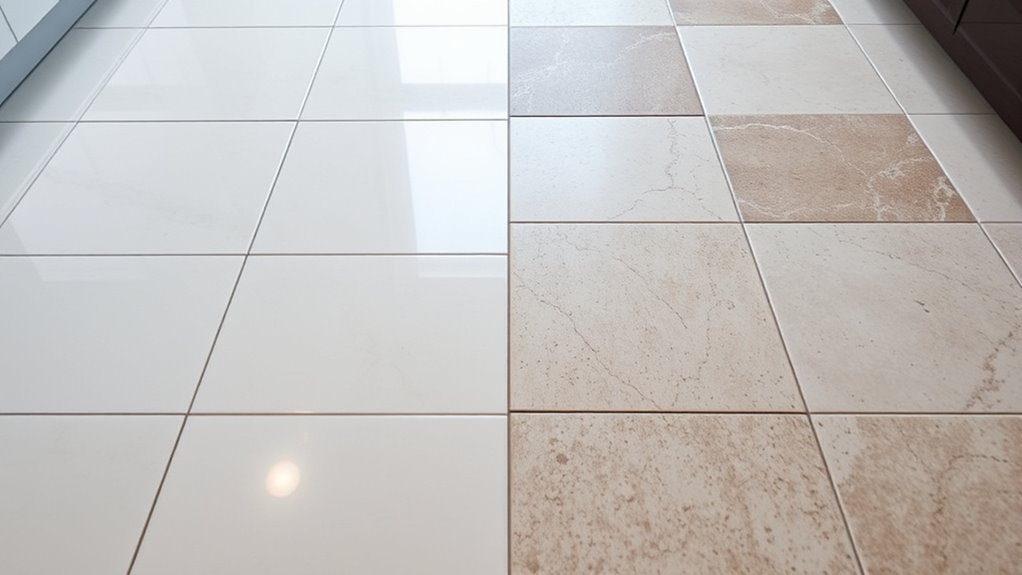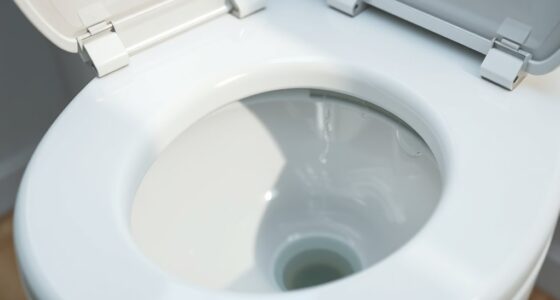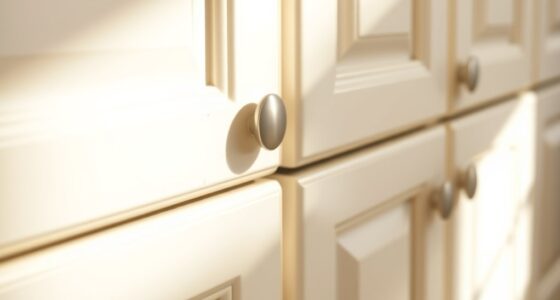When cleaning tile and natural stone surfaces, you need to follow different rules to keep them looking their best. For tile, gentle sweeping and damp mopping with pH-neutral cleaners work well, and sealing grout helps prevent stains. Natural stone, however, requires careful handling with specialized, pH-neutral stone cleaners and regular sealing to prevent damage. Ignoring these distinctions can cause harm, but you’ll discover more ways to maintain your surfaces if you keep exploring.
Key Takeaways
- Natural stone requires pH-neutral, non-acidic cleaners to prevent damage, unlike most tiles that tolerate a wider range of cleaners.
- Sealing natural stone is crucial for stain resistance, whereas many tiles, especially glazed, have inherent low porosity.
- Regular sealing and immediate spill cleanup are more critical for natural stone to maintain its appearance and durability.
- Harsh chemicals like bleach or vinegar should be avoided on natural stone, but may be used cautiously on certain tiles.
- Gentle cleaning methods and avoiding abrasive tools are essential for natural stone, while tile surfaces are generally more forgiving.
Understanding the Composition and Porosity of Your Surfaces

Understanding the composition and porosity of your surfaces is essential because these factors directly influence how materials like tile and natural stone respond to cleaning, sealing, and wear. Natural stone tends to be more porous, making it more vulnerable to stains without proper surface sealing. Tile, especially glazed varieties, usually has lower porosity, offering better stain prevention naturally. Knowing your surface’s makeup helps you choose the right sealing products and techniques to protect it effectively. A well-sealed surface resists moisture and stains, prolonging its appearance and durability. Recognizing the beneficial ingredients in sealing products can further enhance your surface’s protection. By understanding porosity, you can prevent damage before it occurs. Proper surface sealing is key to maintaining your surfaces’ integrity, ensuring they stay beautiful and resistant to stains over time.
Cleaning Agents: What’s Safe and What’s Not
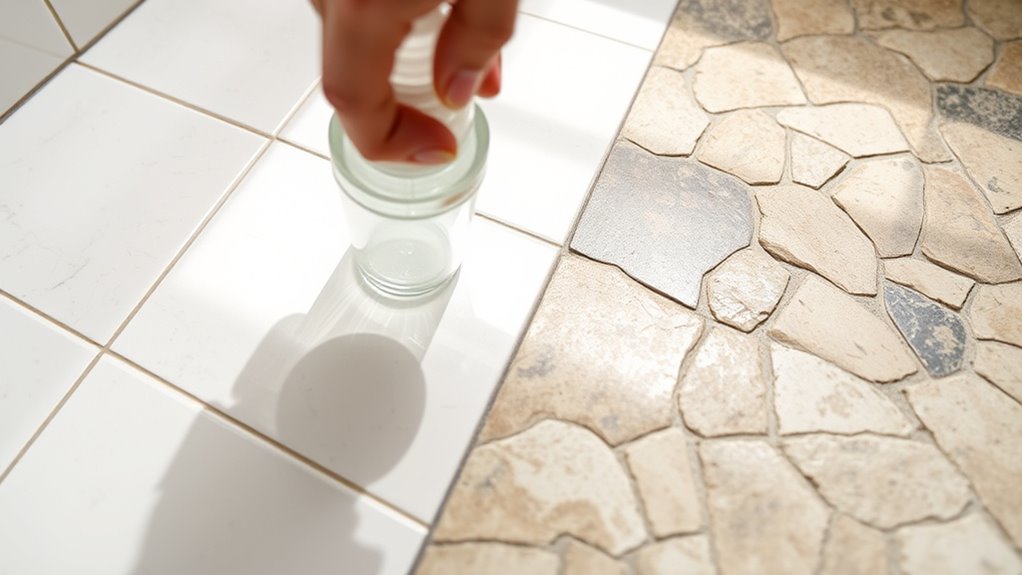
Choosing the right cleaning agents is essential to maintaining the beauty and durability of your tile and natural stone surfaces. Some cleaners can damage the surface or strip away sealing techniques designed to protect against stains. Use pH-neutral cleaners for regular stain removal, avoiding harsh acids or alkalis that can etch or dull natural stone. For tougher stains, specialized stone or tile cleaners are safer options. Always check labels to ensure the product is safe for your specific surface type. Avoid bleach or vinegar, which can harm sealing layers and cause discoloration. Regularly maintaining your surfaces with appropriate cleaning agents helps preserve their appearance and prevents staining. Proper stain removal techniques combined with suitable cleaners will keep your tile and natural stone looking their best for years. Additionally, understanding AI vulnerabilities and implementing safety measures can prevent unexpected surface damage caused by improper cleaning methods.
Maintenance Routines for Tile Surfaces
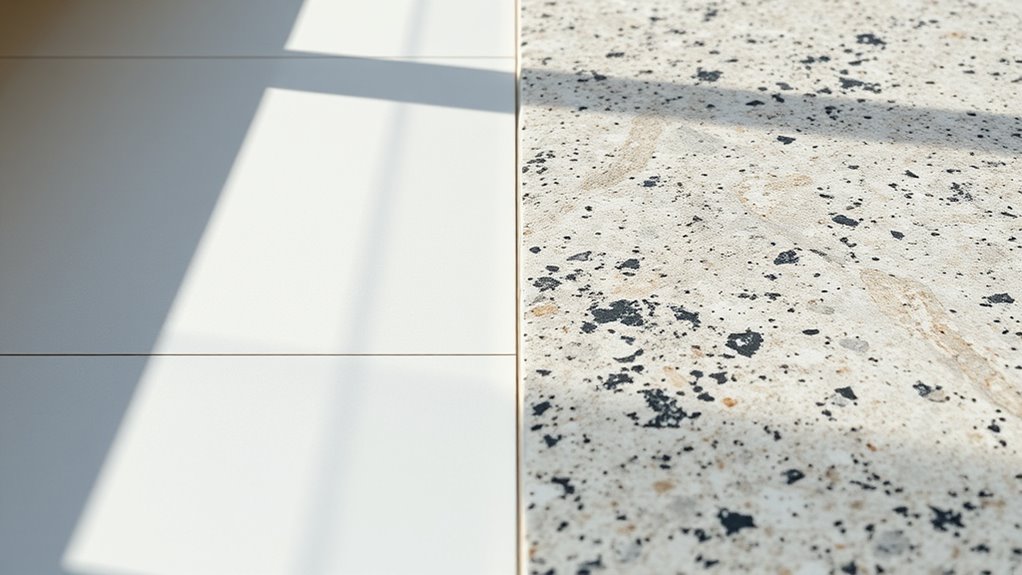
Establishing a consistent maintenance routine is key to keeping your tile surfaces looking their best over time. Regular sweeping and damp mopping help prevent dirt buildup and maintain their appearance. To protect your grout, consider sealing it periodically; grout sealing prevents stains and makes future stain removal easier. When stains do appear, act quickly with appropriate stain removal techniques, using gentle cleaners suited for your tile type. Avoid harsh chemicals that can damage the surface or weaken grout sealants. Consistency is essential—clean spills immediately and reseal grout as recommended by the manufacturer. This routine prolongs the life of your tiles and keeps them looking fresh. Proper maintenance ensures your tiles stay beautiful and functional for years to come. Additionally, understanding optimal angles for pinball machines can help improve game performance and longevity, similar to how proper tile care extends the lifespan of your surfaces.
Special Care Requirements for Natural Stone
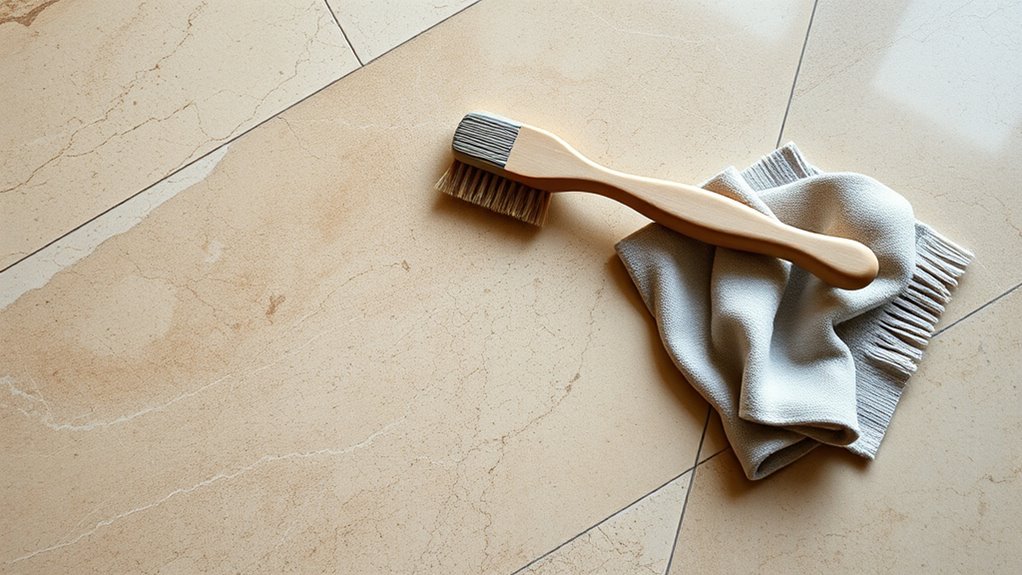
Natural stone surfaces require special care because they are more porous and sensitive than manufactured tiles. To protect your stone, apply proper sealing techniques regularly; this creates a barrier against stains and moisture. Be proactive with stain removal—address spills immediately to prevent permanent damage. Use pH-neutral cleaners specifically formulated for natural stone, avoiding acidic or abrasive products that can etch or dull the surface. When cleaning, gently scrub with soft cloths or sponges to prevent scratching. Remember, sealing isn’t a one-time fix; it needs periodic reapplication to maintain protection. Choosing the right cleaning products is essential to avoid damaging your stone. By following these care requirements, you preserve the natural beauty of your stone and ensure it stays in excellent condition for years to come.
Long-Term Preservation and Restoration Tips
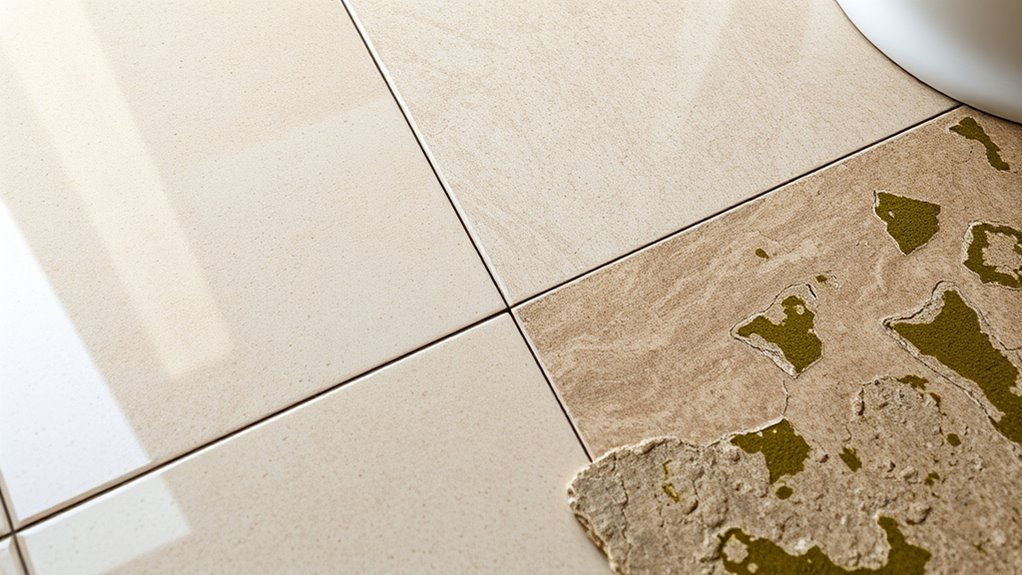
Proper maintenance of natural stone surfaces extends beyond initial sealing and cleaning. To ensure long-term preservation, regularly inspect your stone for cracks or chips and address issues promptly. Use proper sealing techniques, reapplying sealant as recommended, to maintain a protective barrier that prevents stains and damage. Damage prevention starts with consistent cleaning using pH-neutral products and avoiding harsh chemicals or abrasive tools. Place mats or rugs in high-traffic areas to reduce wear and prevent scratches. Avoid placing heavy or sharp objects directly on the surface. When restoration is needed, consult professionals who specialize in natural stone repair to avoid further damage. Incorporating celebrity lifestyle insights can also inspire stylish and practical maintenance routines. By following these tips, you’ll extend the beauty and integrity of your natural stone surfaces over time.
Frequently Asked Questions
Can Homemade Cleaning Solutions Damage Natural Stone or Tile Surfaces?
Homemade solutions can damage natural stone or tile surfaces if you’re not careful. DIY cleaning often involves acidic or harsh ingredients like vinegar or lemon juice, which can etch or dull natural stone. For tile, some homemade solutions are safe, but it’s best to avoid acidic cleaners. Always research your specific surface and test any DIY cleaning method in a small area first to prevent damage.
How Often Should I Reseal Natural Stone Compared to Tiles?
You should reseal natural stone much more often than tiles—about every 6 to 12 months—to protect its surface longevity and maintain its stunning appearance. Tiles, on the other hand, need resealing only every 2 to 3 years. This frequent sealant maintenance for natural stone prevents staining and damage, ensuring your surface stays beautiful and durable. Don’t wait for a disaster—stay ahead with regular resealing to keep your surfaces pristine!
Are There Specific Cleaning Tools Recommended for Natural Stone?
You should use pH balanced cleaners and soft bristle brushes when cleaning natural stone. These tools protect your stone from damage and guarantee a thorough clean without scratching or etching the surface. Avoid harsh or acidic cleaners, which can harm natural stone. Stick to gentle, pH-neutral solutions and soft brushes to maintain your stone’s beauty and longevity, making your cleaning routine effective and safe.
What Are Common Mistakes to Avoid When Cleaning Natural Stone?
Don’t throw caution to the wind when cleaning natural stone; it’s easy to make mistakes. Avoid using abrasive cleaners, which can scratch and damage the surface. Always maintain a proper pH balance with gentle, pH-neutral products to prevent etching. Never use acidic or alkaline substances, as they can harm the stone’s finish. Stick to recommended cleaning methods, and you’ll keep your natural stone looking its best for years to come.
How Do Environmental Factors Affect Long-Term Preservation of Surfaces?
Environmental impact can substantially influence the long-term preservation of surfaces, causing surface degradation over time. You should consider factors like humidity, pollution, and temperature fluctuations, which accelerate wear and damage. By protecting surfaces from harsh environmental conditions, you prevent surface degradation, ensuring durability. Regular maintenance and environmental controls help minimize these effects, allowing your surfaces to stay pristine longer. Being mindful of environmental impacts is key to preserving their beauty and integrity over the years.
Conclusion
Remember, your surfaces are like the crown jewels of your home—treat them with care, and they’ll shine brighter than a thousand suns. Whether you choose tile or natural stone, following the right cleaning rules will keep them looking stunning for decades. Don’t underestimate the power of proper maintenance; it’s your secret weapon against damage. With these tips, you’ll master the art of surface preservation and keep your space looking flawless—more breathtaking than you ever imagined.
